Saïs Report, March-April, 2003
Season Reports
Saïs Report, March-April, 2003
The mission was in the field from the 3rd March to 20th April 2003. There were two main types of work in the season. Firstly, a study of the ceramic material from previous excavations at Kom Rebwa in Sais and secondly, a test trench was excavated in a Saite pottery dump in order to obtain pottery evidence for this period.
The team consisted of: Dr Penelope Wilson (Durham University, Field Director), Gregory Gilbert (Macquarie University, Assistant Director), Eva Laurie (University of Newcastle, Finds Supervisor/Illustrator), Drs Sylvie Marchand and Catherine Defernez (IFAO, Ceramicists), Chad Petrovay (Durham University, Illustrator), Mr Mohammed el Sayed el-Sawaf (SCA Inspector). Funding for the project comes from an Arts and Humanities Research Board grant from the British Government.
Thanks are due to the SCA office in Cairo and to the Chief Inspector in Tanta, Said Abdul Mutalib Kalifa for facilitating our work, to Mohammed Osman, Fatmah Rageb Kamel, Rawya Ismail in Cairo (EES), Mr Ian Bailiff (Durham University, Department of Archaeology), Dr Bernard Mathieu (IFAO), Ashraf and Senne el Bishe and the guards and police in Sa el-Hagar and Bassioun.
Kom Rebwa Ceramic Study
The team and the specialist ceramicists continued work on the pottery sherd material from the excavations at Kom Rebwa in 2001 and 2002. The following tables shows the preliminary classification of the pottery material.
Ramesside Fabrics: Sais-Kom Rebwa Excavation 1
| Fabric | Description | Vessel Types |
| FN2 = Nile B2 | Coarse to medium NS; break is buff coloured with red core, sometimes red-brown with grey core, soft; inclusions: fine chaff, some sand and mica; yellow limestone particles; no surface treatment and colour ranges from buff to orange to red; some painted rims; open forms have carefully smoothed interiors, one open form with bright red slip. | Bowls, large diameter with inverted rims and ring bases bowls, thick walled with marked internal rim large bowls with simple red painted rim carinated bowls with everted rims beer jars hemispherical cups or lids jars without necks, small diameter with orange slip jars without necks, with thin walls and handle directly on the rim jar with rolled rim, slightly everted stands with padded rims chalices |
| FN2/FN3 = Nile B2 | Intermediate ware, well fired and areated; break is brown to red-grey; also like FN2 has fine chaff inclusions but has a number of large sized limestone particles. This is the most common fabric of the studied material | As for FN2 |
| FN3 | Medium fine to coarse NS; break is homogeneous red to orange, or brown with red core; hard compact ware (this distinguishes it from FN2); large powdery yellow particles; fine chaff, sand and mica; cream or orange slip or cream wash; usual surface colour is buff. Rarely occurs. | |
| FN4 = IIIA (Qantir) | Fine to medium fine NS; break is red or red with grey core; hard dense ware; many mica inclusions, sand, some large vegetal particles, some large limestone nodules and carbon particles; brush painted beige, pink or orange slip on surface; large-medium sized bowls often have ‘tiger stripe’ pattern inside. | Mainly closed forms: jars with high neck and inverted rim (cooking pot), neckless jars, jars with high necks and external projection, large jars with extrenal bulge and internal projection, round based very wide jars, gourdes, jars with internal bulge, jars with high neck but no internal bulge, jars with slightly everted high neck. Some cooking pots have been over-fired (brown-black break). Rare open forms: plates with internal rim and wide diameter, sharply carinated cup with rounded and everted rim, rounded base, very wide. |
| FN3/4 | Same as FN4, reddish in colour but thinner. | Cooking pots with high necks; bowls with thin sides and internal rim (long or short); jars without neck, with orange slip. |
| FN5 = Nile C | Very coarse NS; break is red with grey or black core; well fired ware, very porous and not compact; large pieces of vegetal temper, often not burnt; yellow, limestone particles and fine sand; surface often only smoothed by hand. | Domestic ceramics of large diameter made by hand, e.g. string marked wide basins; dokka; pot-stands. |
| FN7 | Coarse NS ware; break is red or red-brown with purple core; soft, hardly fired, porous; fine vegetal temper, limestone nodules; sandy inclusions; white washed surface. | Conical bread moulds — bases and rims(?). |
| FN8 | Very fine NS ware, uniform buff coloured break; soft ware with mica, fine sand and rares black particles; surface is smoothed with buff colour. Rare. | Flasks; handle of a flask with a red-brown polish. |
| FN9 | Very fine NS; break is brown to greyish; dense textured ware; mica, fine sand inclusions; buff polished slip on surface. Rare. | Flasks. |
| FN10 | Very fine, hard NS. |
The overall results suggest that the buildings excavated there contain material dating to the Ramesside period (1250 to 1100 BC) and that it is homogeneous in nature. The pottery is mostly domestic in nature and comprises bread trays and bread moulds, beer jars, bowls (conical shape, large food processing bowls), large jars (meat jars), some Canaanite amphorae and other storage amphorae, a few imported pilgrim flasks, chalices and a very few fine wares (see Table 1 for description of fabrics and vessel types). The analysis seems to imply that the area under excavation was mostly used for the preparation of food and the storage of various products. It may have been a complex supplying food for consumption in the main settlement or building complex in this place. The confirmation of a large Ramesside settlement at Saïs is not too surprising but maybe should be seen in the light of the Ramesside interest in the western Nile Delta and beyond. The pottery sherd material from Kom Rebwa contains some imported amphorae and Syro-Palestinian wares, but nothing that would reflect contacts to the west and Libya. The amphora here fit well within the corpus of material from Ramesside Egypt as a whole such as that from Qantir and Zawiyet Umm el-Rakham. The nature of the Kom Rebwa material suggests that either this Ramesside settlement was the last settlement in this part of the site with nothing being added here later, or that the Saïte and later buildings once here have been completely removed from the top by sebakhin. Further work needs to be done to investigate the phases of settlement here.
Excavation 4 : Ancient Saïte Pottery Dump
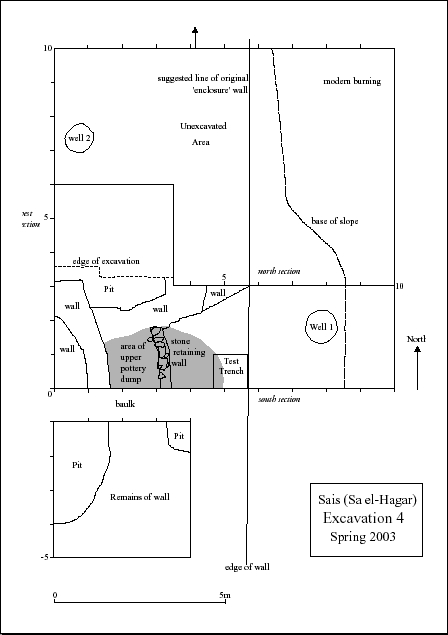
An excavation area was opened up in the western area of the Great Pit, where a test section had been dug in 2000.
The aim of the work was to recover Saïte pottery in order to begin to form a corpus and catalogue of Saïte pottery from Saïs equivalent to that of the Ramesside period from Kom Rebwa. The 2000 section had shown that the pottery here dated to the 6th-5th centuries BC and it seems that this is one of the few larger areas of land left at Saïs with obvious Saïte deposits close to the surface. A 10m by 10m area was marked out, but a first test strip of only 3m by 10m was excavated. It immediately became clear that the area was extremely pitted and disturbed and was in fact an ancient rubbish dump. It was also clear that the pottery in it was all from the Saïte period (664-525 BC) and no later (Ptolemaic) material could be detected. This seemed to suggest that any material removed from above this area and between the modern track and the excavation area could have dated to a later period but had been removed. The upper layers of the trench contained pits of pottery and burnt rubbish. Below the first metre however a pot dump was discovered containing layer upon layer (7 clear levels in all) of complete but broken vessels which represented the main types of pottery also being found in the rubble filled dumps.
The Pottery and Finds
There were many different types of foreign, imported amphora including a number of East Greek types. They comprised: Phoenician amphorae of two types of ware, Clazomenian amphorae with painted red stripes, Chian amphorae with white slip and red painted decoration and possibly local imitations of these vessels, Lesbian ‘Phi’-amphorae of grey ware, so-called ‘Samian’ and ‘Protothasian’ amphorae. These all dated to the last half of the sixth century BC (550-500 BC) (Cook and Dupont, 1998, 142-190). There were also a small number of fragments of decorated East Greek fine ware pottery. The best example was part of the top of a Fikellura amphora with lotus and bud decoration and cable motif dating to around 550 BC (Cook and Dupont, 1998, 46, 80).
There were also various types of bowl and jar made from Nile silt ware, and an interesting group of red polished Nile silt wares including globular pots and tall cylindrical vessels with ridged necks. Though there seemed to be a large number of foreign imported wares, in fact, a count of the material from a small section showed that the Nile silt wares dominated the ware types. The whole vessels were mostly cracked and broken but had retained their form so that they could be removed as whole assemblages in order to be reconstructed and drawn for the pottery typology.
A number of small objects were also found amongst the pottery and they included fragmentary miniature offering bowls, incense burners, lamps, faience amulet fragments such as wedjat-eyes, some Dynasty 26 small sculptured objects in limestone (including two crude human heads, a broken temple doorway votive offering and parts of votive altars). There were also some fine wares of a fine marl clay used to make small bowls and also fragments of Dynasty 26 New Year flasks of faience and pilgrim bottles. Fragments of miniature Bes-jars were also found. Even though a relatively small area was excavated, enough pottery was found for study.
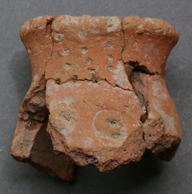 Bes jar. | 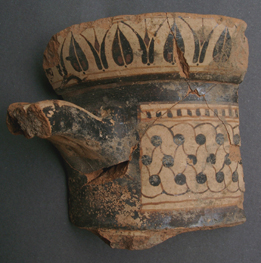 Greek black-figure amphora. |
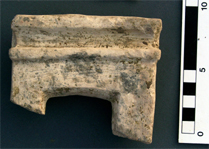 Limestone votive door fragment. |
The Well
In the western end of the section, there was a well measuring 1.86m in diameter and made up of circular segments of coarse Nile silt ware, each approximately 35 cm high. It was possible to clear the well to a depth of 3m, with 13 of the segments in place and a further two detected by the excavator continuing down through the mud. The well contained smashed pottery of the types found in the pottery dump already investigated and some almost complete examples of the red polished globular jars, Phoenician amphorae, beer jars and small plates. This context again had a homogeneous context of material and may have been deposited within a relatively short time span as much of the pottery was coated with a black oily substance which had evidently been poured out of one of the vessels. This was a coarse Nile silt ware vessel that had been discarded into the well at some stage. Bones, a fragment of East Greek fine ware and part of a Saïte ‘Fire-Dog’ were also found down the well. A second, smaller well 90cm in diameter was found on the surface to the north but not excavated. At the end of the work, the well was refilled and a brick wall was built around and over it in order to protect it, as it seems to be a unique and rare find.
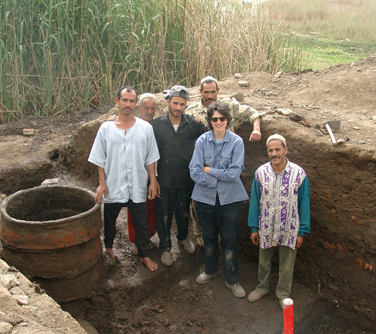 | 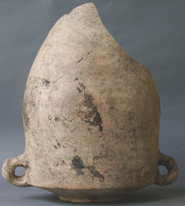 |
The well (above) with (right) Phoenician amphora.
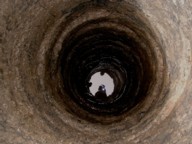 View down the well. | 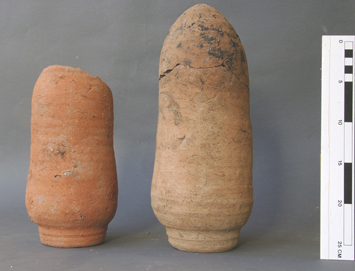 Beer jars found in the well. |
The Wall
The western end of the trench contained a major mud brick wall made up of sandy bricks and pottery-fragment, filled bricks. This wall had a small retaining structure of stones built up against it which formed the base of the multi-layered pottery dump already excavated. The retaining structure seemed to be founded on the edge of the mud brick wall and to be aligned in a north-south direction. The depth and width of the main wall were difficult to determine because the wall had been so pitted and damaged. It seemed as if the pottery had been dumped inside the wall in order to provide a fill for a building foundation platform. The rubbish and debris, though containing votive offerings was too broken to be a deliberate votive offering dump. As this fill material is late Saïte in date it would have to have been dumped as fill after or during the Saïte period. It was not contaminated by later pottery suggesting that the fill-contexts were all within this time period (550-500 BC). In addition, the sections of the trench suggested that, in fact, the pottery had been dumped in loads and a layer of broken pottery had been put at the top of the loads, level with the top of the surviving wall. This may then have formed the foundation base for a refounded or refurbished building during the late Saïte period.
The date of the wall was further investigated by a trench to the south where the remnants of a wall had been noticed in the section. The remaining wall here ran through into the main trench and, again though very pitted, it confirmed that we had found the western edge of the wall and suggested that the original width of the wall was at least 5.60m. The eastern edge of the wall has not yet been found. At this width the wall may be an Enclosure wall and may have run further to south where there is now a void. It would seem likely that the sebakhin had dug out the mud brick from this enclosure wall completely and this explained why in our trench to the south with Prehistoric material there was virtually nothing on top of the Prehistoric levels. Evidently the wall had been founded directly upon the levels existing at the time of foundation. From the bricks in the wall, which measured around 42 x 32 cm it seemed possible that the wall could have been either Saïte or Ramesside in date. In order to ascertain the date of the wall, part of it was removed to investigate the foundations. The layers of bricks were very clear with a layer of sandy brick, then a layer of muddy bricks. These layers were founded on a thin layer of surface fill and then came down onto natural Nile silt. This material was thick blue black layers of sediment, often found by us in the drill core work. The layer of fill at the bottom of the wall and spread onto the Nile silt contained pottery which was Saïte in date. The wall is therefore a Saïte new foundation, newly founded upon Nile mud sediments. The material in the fill directly adjacent to the wall may be part of the foundation trench, though as the wall has been partly dug away it suggests that it was deposited there later.
From the local topography it is possible, that a second Enclosure wall was founded a little further to the west later in the Saïte or Ptolemaic period. At that time the inner Enclosure wall may have been used as a platform for workers buildings and then for dumping rubbish from the new complex in this area. The burning and pottery piles in this area suggest domestic and workmen’s settlements types of material rather than an industrial area. In addition, the wells are dug down, perhaps through some of the pottery rubbish, to provide fresh drinking water for the people working here. The workmen may have been those brought in to work on a second, later enclosure wall founded to the west of the earlier wall, who used the remnant of the early wall as a foundation for their workshops and crude dwellings. The detailed study of the pottery will help to clarify the sequence of the material and should be middle to late Saïte in date. It is also tempting to connect these areas with the squatter occupation of the Temple Complex of Neith reported on the Wedjahorresne statue in the Persian period. The main well in the excavation area may have been deliberately spoiled by pouring oily resin down it and perhaps firing it. It is not clear if this was done deliberately to stop people living here, accidentally or mischievously.
Finds
Most of the finds were damaged or broken in some way and all were affected by salt damage. Upon drying, the salts inside the objects surfaced causing further damage. In order to minimise the effects of this process, the objects were soaked in water which was frequently changed to desalinate them, to some extent, where possible. Stable objects, broken in pieces, were repaired with reversible glue where appropriate. Many finds are still awaiting full study when the work continues, but date to Dynasty 26.
| Description | Dimensions | Material | Context | Reg. Number |
| wedjat-eye amulet | 3.4×2.4×0.45 cm | faience | [4001] | 10 |
| papyrus amulet | 5.6×1.4×1.3 cm | faience | [4003] | |
| Ptah-Pataikos amulet | 3.0×1.2×1.1 cm | faience | [4003] | 9 |
| wedjat-eyes amulet | 2.1×2.7×0.4 cm | faience | [4011] | 11 |
| bun-shaped weight | 1.5 (D)x0.8 cm, 3g | iron ore? | [4017] | 5 |
| scarab mould | 2.6×2.5×1.7 cm | pottery, NS | [4011] | 8 |
| plate | 20.7 (D)x 3.2 cm | pottery, NS B2 | [4007] | 4 |
| bread plate | 29.1 (D) x 5.1 cm | pottery, coarse NS | [4001] | 3 |
| beer jar | 11.6 (W) x 27.8 cm | pottery, NS | [4014] well | 2 |
| jar | 24.5 (W) x 33.5 cm | pottery, NS | [4014] well | 1 |
| head of person | 3.1×3.3×3.3 cm | limestone | [4017] | 6 |
| head of woman | 5.5×3.0x1.6 cm | limestone | Test Trench | 7 |
Conclusion
The test trench contained material dating to the late Saite period around 540-500 BC and contained a pottery dump and temporary structures built on top of an earlier Saite wall. A well, perhaps used to provide water for the people in those structures was abandoned at the end of the Saite period and may have been deliberately disabled with oil.
Bibliography
Cook and Dupont, 1998
E. Cook and P. Dupont, East Greek Pottery, London: Routledge 1998.
